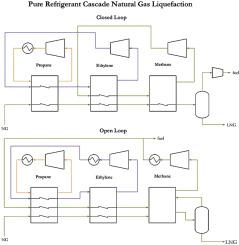Gas Science and Engineering ( IF 5.285 ) Pub Date : 2021-02-20 , DOI: 10.1016/j.jngse.2021.103868 Carlos Arnaiz del Pozo , Ángel Jiménez Álvaro , Javier Rodríguez Martín , Ignacio López Paniagua

|
Natural gas liquefaction allows to transport this energy vector over long distances from stranded reserves to the market. Pure Refrigerant Cascade processes will be responsible for more than 105 mtpa of the LNG base-load production by 2021. Classical Cascade process developed by ConocoPhillips consists of three pure component closed refrigeration loops at several pressure levels. Alternatively, the open cycle Optimized Cascade process operates the methane loop in open cycle, where the flashed vapours are recompressed and recycled to the natural gas feed, after cold recovery. Literature on Pure Refrigerant Cascade natural gas liquefaction processes is scarce, therefore a comprehensive evaluation of the two configurations is presented in this study. Specific power consumption resulted in 357,2 and 323,7 kWh/ton LNG for the closed and open cycle base cases respectively, i.e. approximately 10% higher LNG throughput for the latter for equivalent available horsepower. Sensitivity to the presence of N2 in the feed stream reveals a larger detrimental effect on the performance for the open cycle process, resulting in a reduction to 5% additional LNG throughput relative to the closed configuration, when the feed stream contains up to 0,5% mol of N2. The sensitivity to the cooling media resulted in a similar increase of 0,8% LNG production for every °C decrease in the process stream aftercooling temperature for both models. The subsequent exergy analysis showed that the irreversible losses for valves, cryogenic exchangers, compressors and mixers were lower for the open cycle topology, while the exergy destruction taking place in the heat rejection units notably increased. Overall, the exergy efficiency of the open cycle was around 4%-points higher than for the closed cycle. The calculation of the coefficients of structural bonds (CSB), revealed that investment and research efforts should preferentially focus on minimizing temperature approaches in the cryogenic exchangers.
中文翻译:

通过(火用)分析评价闭环和开环纯制冷剂级联天然气液化过程的效率。
天然气液化允许将这种能量矢量从滞留储量到市场进行长距离运输。到2021年,纯制冷剂级联工艺将占LNG基本负荷生产量的105 mtpa以上。康菲石油公司开发的经典级联工艺由三个处于不同压力水平的纯组分封闭式制冷回路组成。或者,开放式循环优化级联过程以开放式循环运行甲烷回路,在此过程中,闪回的蒸气在冷回收后被重新压缩并再循环到天然气进料中。关于纯制冷剂级联天然气液化过程的文献很少,因此,本研究对这两种配置进行了综合评估。单位功耗导致357,2和323,封闭和开放循环基准案例的LNG分别为7 kWh /吨,即在等效功率下,后者的LNG吞吐量大约提高10%。对氮的敏感性进料流中的2揭示了对开放循环过程的性能有更大的有害影响,当进料流中包含最多0.5 mol的N 2时,相对于密闭配置,LNG的额外通量降低了5%。对冷却介质的敏感性导致两种型号的冷却后温度每降低1°C,LNG产量就会增加0.8%。随后的火用分析表明,对于开式循环拓扑结构,阀门,低温交换器,压缩机和混合器的不可逆损失较小,而在排热装置中发生的火用破坏显着增加。总体而言,开放式循环的火用效率比封闭式循环的火用效率高约4%。对结构键系数(CSB)的计算表明,投资和研究工作应优先集中在使低温交换器的温度方法最小化上。



























 京公网安备 11010802027423号
京公网安备 11010802027423号